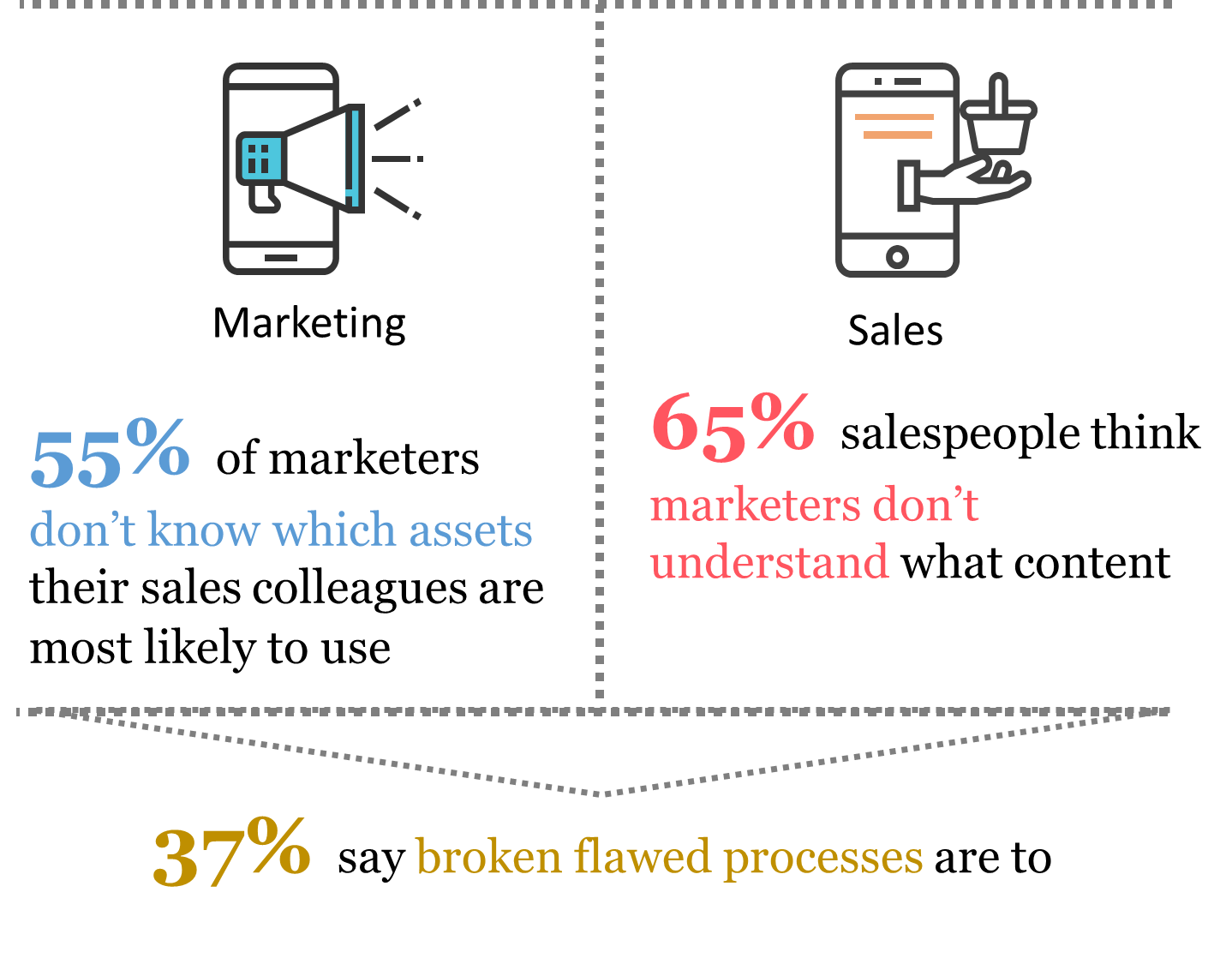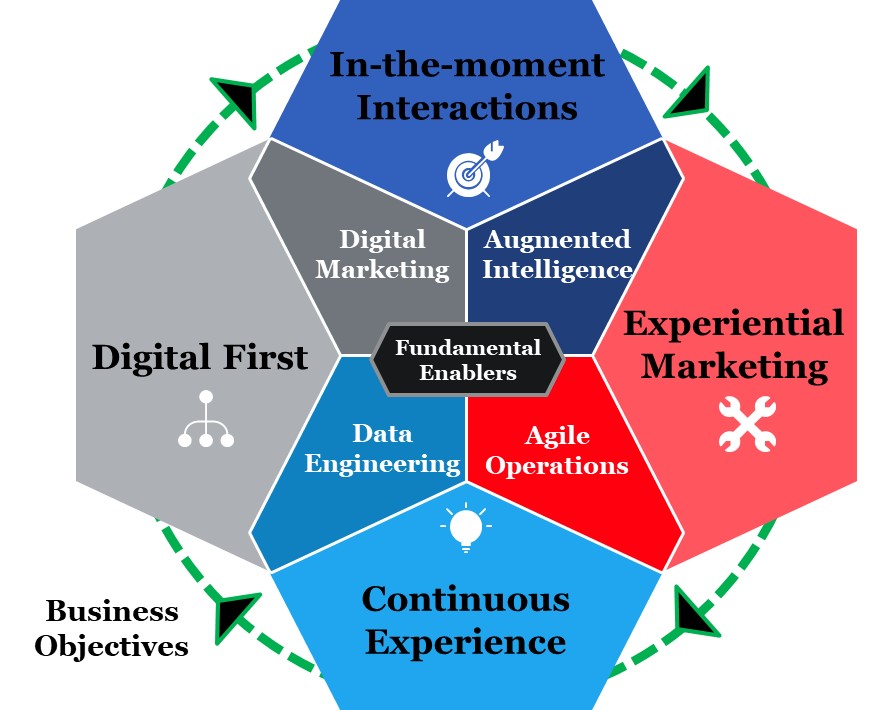Transforming Customer Experience through Unified Business Functions
3AI May 6, 2022

Author: Souvik Das, AVP – Platforms & Offerings, Genpact Digital and Pramit Dasgupta,VP – Platforms & Offerings, Genpact Digital
The recent pandemic has changed customer expectations and interactions in many ways. Forever.
As organizations evolve through the new normal and gear up to satisfy their customers, there is a need to rethink and redesign how an enterprise level digital marketing system should operate.
The statistics beside reflect the state across organizations at present:

The essential change advocates placing the customer at the heart of all actions, because more than ever, customers today mandate a relevant, useful, cohesive, and contextual interaction to develop their brand experience.
However, C-suite leaders are realizing, that it is not a very low hanging fruit to pluck. Mere cross-functional operating models fail to cut the corners as effectively as needed. Functions like marketing, customer service, sales etc. keep operating in silos with some incremental cross communication. But that is far from a truly enterprise model of unified business functions
1. Target State
To explain in few words, a unified business function should be able to drive customer communications that fulfil:
- Being relevant – communications and actions that map to the customers (or their personas) and their plotted behavioural patterns /preferences
- To be useful – requires guided actions e.g., for a customer service interaction or a relevant marketing / sales offer to be serving the customers’ current needs / challenges
- A cohesive customer communication – is one that ensures seamless interconnection across channels, so that a customer is not starting from scratch or experiencing various versions of the same journey between channels.
- Contextual customer interactions – is one that finally drives One Experience achieved by stitching multiple views of the same customer e.g., from marketing, sales, customer service etc. such that every interaction is based on the latest data and insights from all the functions.

An example should help elucidate. Let’s say Mary is a loyal customer of ABC Bank. But recently, due to certain financial hardships, her credit card bills have shot up. Being a regular payer of bills on time for past 9 years, she expects her bank to understand and waive off the late fees. A higher credit limit would also be very helpful. Mary speaks to customer service for a late fee waiver and mentions her current difficulties. While checking her mails afterwards expecting the waiver, she however finds an auto loan proposal from her bank. Even the dedicated sales rep calls in to offer further discounts on the interests if she purchases the auto loan in next 15 days. Clearly here the customer service, marketing and sales are disjointed and in that incoherence the bank is missing out on the vital “One View” of the customer’s current state and needs.
On the other hand, a unified business function would have noticed, recorded, analysed, and passed on the required list of optimum actions to all the connected functions. Mary would have received a useful mail agreeing to the late fee waiver, along with relevant details and links for a payment holiday for the next three billing cycles. As Mary logs in to the link to accept the payment holiday, she finds all the contextual information pre-filled in, which she just needs to verify and accept the T & C. But Mary still has few queries and calls up the customer service. To her great satisfaction, the service rep who answers her call seems to be already aware of her questions. The rep directly jumps into explaining and educating her on the process. On top of that she receives a follow-up text, offering a higher credit line honouring her long relationship with the bank. Clicking the link Mary starts to fill in the two-pager form on her mobile. She then decides to finish it off from her laptop and is amazed to find that it starts exactly from where she left off in her mobile. Mary is so delighted at this cohesive experience; she can now think of no other bank but ABC!
This article is an attempt to establish and emphasize on a structured viewpoint to enable enterprises transform or at least set sail towards achieving Unified Business Functions focused on personalized, timely, useful, connected omni-channel interactions.
2. The Foundation
All that could happen with Mary sounds magical. Every enterprise desire to achieve that state of unison. However, easier said than done, companies have been trying to adopt this unification for over 20 years now. The CMO Council reports* that “only 14% of marketers say that customer centricity is a hallmark of their companies, and only 11% believe their customers would agree with that characterization.”
Enterprises need to overcome technology, cultural and organizational challenges.
The need of the hour is to reach for the consumers’ wallets, not by pushing, but by making a sincere effort to create a “stickiness” by enhancing experience through an integrated sales, marketing, and customer service function.
From the operational angle, the potential interaction touchpoints for customers in a multi-channel ecosystem involves both traditional (Print, TV, and Direct mail) and Digital (websites, social media, apps, OTTs etc.) channels. To ensure consistently good and seamless experience to the end customer, unified functions need to be implemented covering all the active channels.
On the data side, several petabytes of data generated every minute, find residence in independent siloes with boundaries and inconsistencies that make it cumbersome to integrate and analyse. This hinders creation of comprehensive customer journey maps with orchestration, data and technology layers sitting in different control towers spread across functions. Data joined manually or for ad hoc purposes are not a sustainable or scalable endeavour. Making it real time is even a taller claim. It essentially needs all these functions to feed into and populate a unified account of the customer containing the recent, relevant, and standardized version of the truth.
Identifying the right ingredients is the starting point.
- Business objectives (representing the end-state CX goals) should aptly capture how the enterprise wants to solve what modern customers expect from an evolved interaction and
- the fundamental enablers represent important workstreams that will join the major functions.
Well-crafted business objectives should be able to pull in the right enablers which can then enhance customer experience across every interaction (by making them relevant, useful, cohesive & contextual).
In the pictorial below, the fundamental enablers near the centre (since they are closer to the business to control and grow) facilitate in achieving the outer layer (that touches the end customer) with all the business objectives relating to each other. What enterprises need are defined processes to ensure that these enablers are activated and connected.

Therefore, the question to be asked is: do you have all the right enablers in place and are they tuned towards driving the objectives that can finally deliver winning interactions resulting in delightful experience?
3. The Process
Demystifying the optimization of multiple complex and non-linear touch points across customer interactions is the key. This brings us to the process, i.e., the action milestones needed towards activating the fundamental enablers.
The following pieces with the right balance will be capable of driving the targeted level of experience delivery:
- Know the data common grounds – map the metrics, finding commonality and variation across KPIs, catalogue, standardize and normalize
- Create an enterprise wide, integrated, multi-source, data repository (e.g., Data Lake / Data Cloud)
- Detailed journey maps that plot complex customer interactions by use cases and personas
- Advanced Analytics COE for actionable insights mining, made scalable through application of AI / ML
- A persistent, unified, and updated Customer One-View, accessible to all contributing systems and functions
- An Orchestration layer suited for executing at speed and scale
- Cohesive omni-channel interactions connected to all the functions
- Intelligent service layer enabled with modern technologies and techniques, and finally
- The One Experience Command Centre, which co-ordinates all the above processes singly focused on CX.
Hence, the process jigsaw (which can be your checklist as well) will look like:

Conclusion
To conclude, keeping a common goal with the customer at the centre, drives standardization across processes eliminating redundancies, choke points and effort. AI/ML interventions play a key role here by continuously feeding the right learning at the right time from the tech stack to the processes, thereby making the entire set-up agile and responsive. The key highlight is the use of cross functional data at each step of the journey. This is the only way organizations can truly replicate and understand a customer’s journey, aspirations, paint points and preferences that eventually help them to rethink and refine the strategies around each of this step.
While every organization is probably at some phase of visualizing the desired unified end-state, it is not easy to attain the nirvana. Informed planning and smart execution by enabling and activating the right pieces under one control, unified over CX focus as the omni-potent culture is essential.
Reference
Aligning Your Sales And Marketing Teams – Forbes Business Development Council – George Donovan
Marketing and Sales Content – Differences That Matter
https://marketinginsidergroup.com/content-marketing/marketing-sales-content-differences-matter/
Why Your Marketing and Sales Teams Should Work Together – by Emily Gork
https://hanloncreative.com/hanlon-insight/why-your-marketing-and-sales-teams-should-work-together/
Mastering Adaptive Customer Engagements
https://www.cmocouncil.org/thought-leadership/reports/mastering-adaptive-customer-engagements






